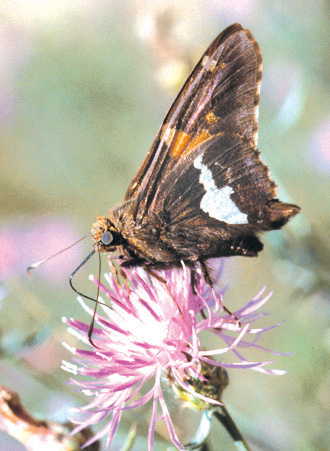Silver-spotted skipper
Order: Lepidoptera
Family: Hesperiidae
Genus and species: Epargyreus clarus (Cramer)
This large, conspicuous, and easily identified skipper occurs in disturbed and open forest situations in southern Canada, most of the continental United States, and northern Mexico. The wingspan is 1.8-2.6 inches. The fore wing has a broad, angular, translucent gold patch, and the hind wing has a small, blunt posterior lobe and distinctive metallic silver patch on the underside. Adults select many kinds of summer flowers, especially pink, red and purple flowers, as nectar sources. Males perch on leaves and twigs and pursue large insects that come within range. Their rapid, darting flight is often difficult to follow. Females deposit eggs singly on leaves of food plants. The caterpillar’s preferred host is black locust, but it will also consume leaves of sticktight (Desmodium), bush clover (Lespedeza), and other legumes. The larva is light yellow, with fine, dark lines crossing from side to side over the back. Its head is rust red and has two large, round, yellow-orange spots low on the front. Caterpillars cut and fold leaflets of compound-leaved legumes to create shelters, abandoning older shelters as they grow. Larger and more mature individuals require larger shelters, which may consist of several leaflets. This species has more than one generation each year, and it seems that adults are present all summer after their first appearance in late May. Large numbers of them appear in July. The species winters as pupae.

